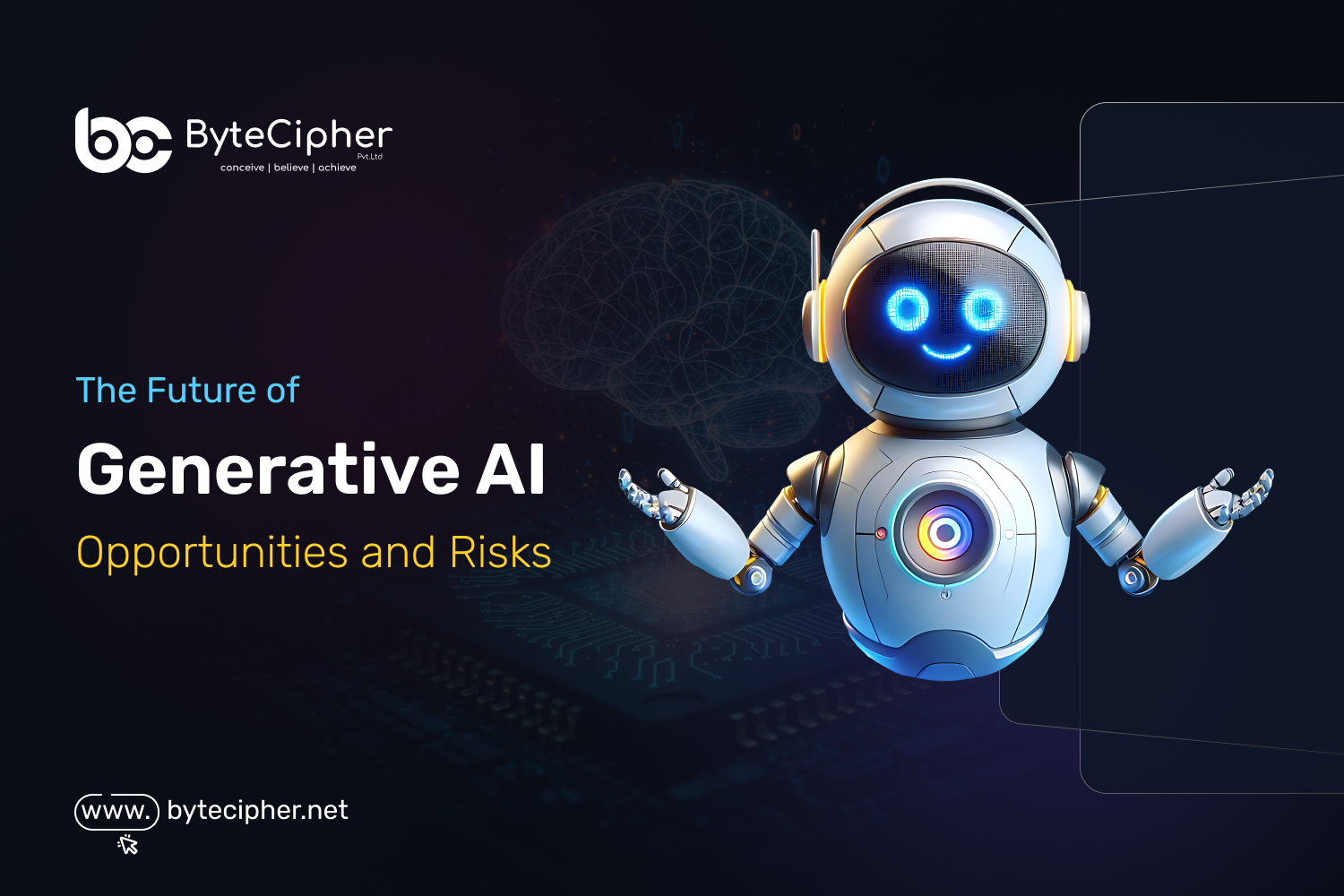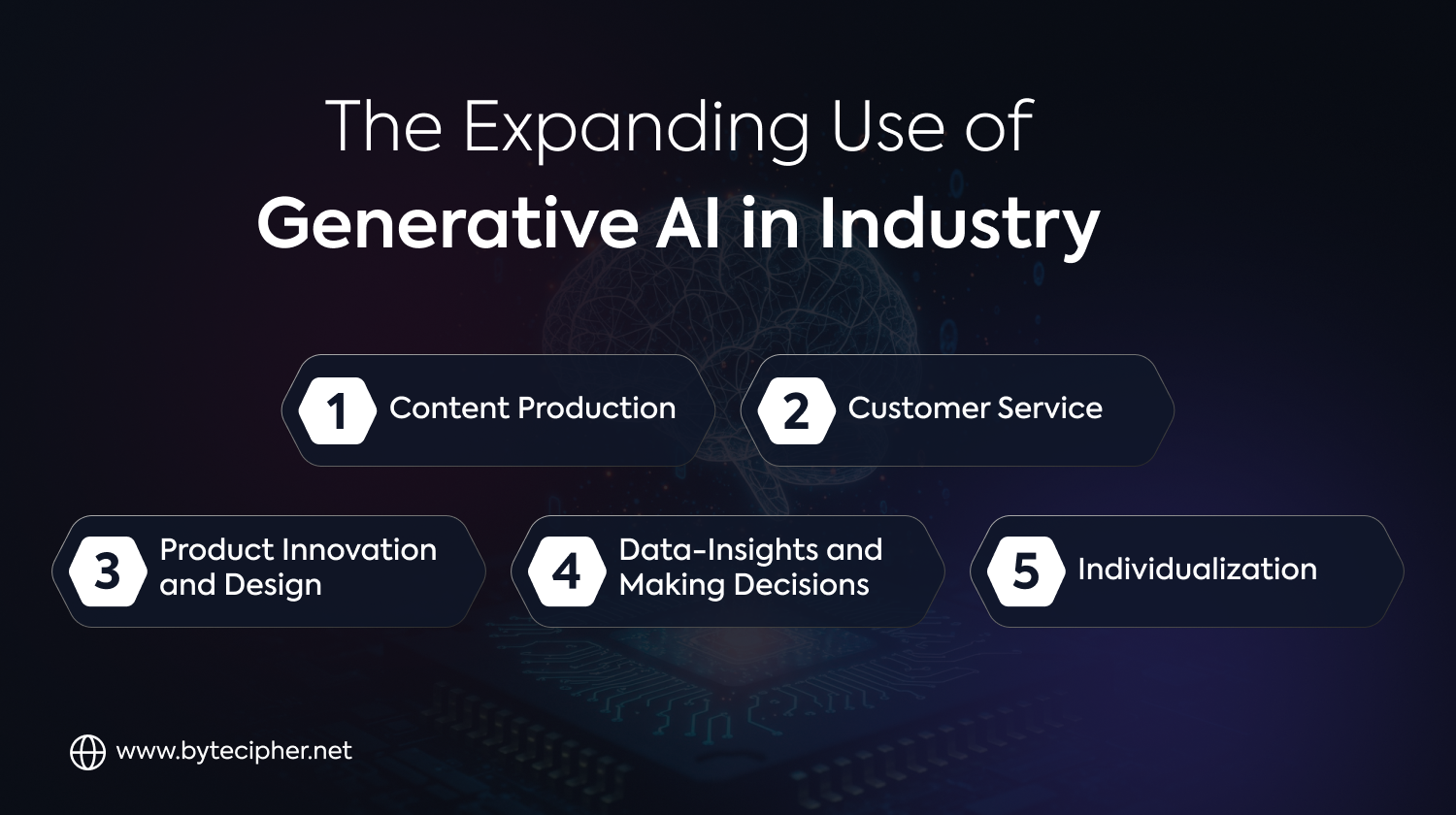
In recent years, one of the most revolutionary and disruptive technologies has been generative artificial intelligence. It is now a powerful tool used in many different industries for everything from writing software code and designing products to producing literature, photos, and music. Businesses, governments, and society must carefully weigh the risks and opportunities that come with this technology, just like any other.
This blog examines the main characteristics and prospects of generative AI, as well as its business effect, risks, and opportunities.
Key Features of Generative AI
A number of distinguishing characteristics of generative AI from standard AI include:
-
Generating content involves producing text, photos, audio, and video.
-
Beyond the data that is already available, creativity and innovation provide unique concepts and creations.
-
Human-like Interaction enables sophisticated chatbots and conversational AI technologies like ChatGPT.
- Managing tasks at scale, such as creating thousands of product descriptions or design variations, is known as scalability.
-
Adaptability acquires new information and changes in response to user input.
-
Combining text, graphics, audio, and video into a single AI model is known as multimodal capabilities.
Possibilities for Generative AI
Innovation, efficiency, and creativity are made possible by generative AI across a variety of industries. Among its greatest prospects are:
- Enhanced Creativity: Helps create fresh concepts, artwork, and entertainment material for product development, marketing, and entertainment.
- Increased Productivity: By automating monotonous processes, professionals can concentrate on strategy and problem-solving.
- Personalization: Enables learning paths, experiences, and recommendations that are specific to each user.
- Healthcare Innovation: Accelerates tailored treatment planning, medical imaging analysis, and drug discovery.
- Cost Reduction: Simplifies processes, lowers the price of producing content, and speeds up prototyping.
- Business Growth: Makes new business models possible, like platforms for creating content powered by AI, SaaS tools, and synthetic media solutions.
Concerns with Generative AI
Generative AI presents serious hazards in spite of its advantages:
-
Deepfakes and misinformation: Artificial intelligence (AI)-produced fake news, photos, and videos have the potential to deceive viewers and damage reputations.
-
Bias & Ethics: AI that has been trained on biased data may produce discriminating results or propagate preconceptions.
-
Intellectual property issues: It’s still unclear who is legally responsible for AI-generated music, art, or code.
-
Displacement of employment: Automation may threaten some employment, particularly those that require creativity or repetition.
-
Cybersecurity Risks: Malevolent actors can create phishing emails, phony identities, or malicious malware by using AI.
Finding the Balance
The appropriate adoption of generative AI is key to its future. Companies and authorities need to collaborate in order to:
-
Establish rules and ethical standards for the application of AI.
-
Boost the explainability and transparency of AI results.
-
Invest in retraining employees to handle changes brought forth by AI.
-
Promote human-AI cooperation as opposed to complete replacement.

Risks and Difficulties
Businesses gain a great deal from generative AI, but there are a number of risks and difficulties that should be carefully considered before implementing it. If ignored, these problems may have an effect on long-term viability, brand reputation, and trust. Let’s examine the main obstacles in greater detail:
1. Protecting Privacy and Security of Data
Massive datasets, some of which may contain private or sensitive data, are used to train generative AI systems. Data leaks, abuse, or exposure of private client and corporate information are possible if improperly managed. To prevent breaches, companies need to put strong security frameworks in place, make sure that data protection laws (such the GDPR) are followed, and have stringent governance procedures.
2. Refraining from Using AI Too Much Without Human Monitoring
Although AI is strong, it is not perfect. When automated decision-making is overused without human scrutiny, it can result in mistakes, inaccurate information, or even noncompliance with regulations. An AI-generated legal document or financial report, for example, might have errors that have major repercussions. Companies need to continue using a human-in-the-loop strategy, in which human judgment is used to supplement AI skills.
3. Addressing Fairness and Bias in Applications That Interact with Customers
Generative AI algorithms pick up knowledge from pre-existing datasets, which frequently exhibit societal biases. Discriminatory, unjust, or deceptive results may arise from this. Applications that interact with customers, such as recommendation engines, chatbots, and recruitment tools, may be subject to legal ramifications and harm brand credibility. To ensure ethical AI practice, businesses should invest in fairness audits, varied training data, and bias detection.
4. How to Handle Intellectual Property Conflicts
Ownership of intellectual property (IP) is one of the most hotly contested issues surrounding generative AI. Who is the owner of the rights when an AI system produces a piece of code, a marketing campaign, or an artwork—the user, the AI developer, or the people who created the original training data? Since the laws governing AI-generated content are still developing, companies are at risk of legal issues. Developing explicit laws regarding content ownership, licensing, and usage rights is necessary before implementing generative AI on a large scale.
FAQs
Q1. What is AI that is generative?
Generative AI describes AI models that use patterns found in massive datasets to produce new material (text, images, audio, video, and code).
Q2. Which sectors gain from generative AI the most?
The sectors most affected include e-commerce, software development, marketing, healthcare, education, and entertainment.
Q3. How dangerous is generative AI?
Among the main threats include bias, false information, intellectual property problems, employment displacement, and security issues.
Q4. Can generative AI take the place of human labor?
Even if some jobs might be automated, generative AI is more likely to support human labor by managing monotonous chores while people concentrate on strategy and creativity.
Q5. In what ways may companies responsibly implement generative AI?
By tackling bias, safeguarding consumer data, maintaining transparency, and utilizing AI as a tool for collaboration rather than as a substitute.
Final Thoughts
Generative AI is changing industries, encouraging innovation, and opening up new economic prospects for companies all around the world. At the same time, it creates problems related to security, ethics, and false information.
Our ability to mix creativity and accountability will determine the direction of generative AI. In this new era of digital transformation, companies who use AI effectively—by fusing human ingenuity with AI’s capabilities—will prosper.



